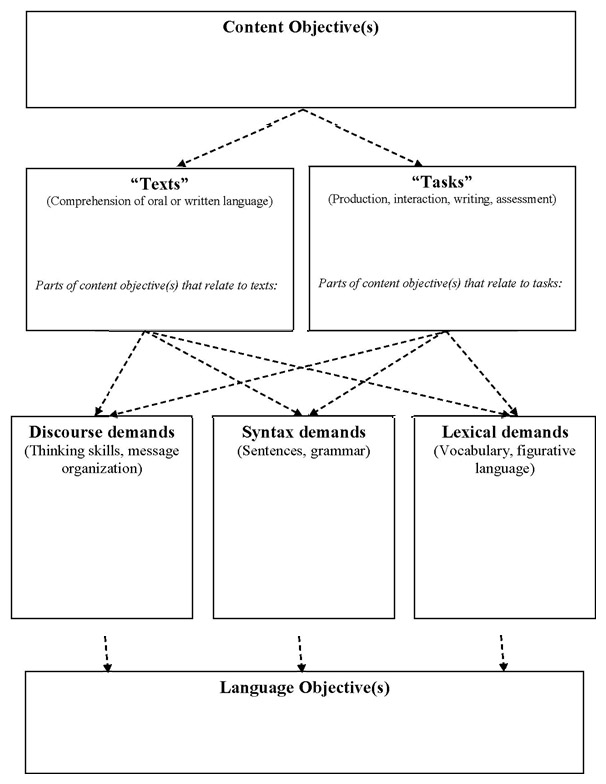In the new environment of academic learning, we need to address both content standards and English Language Development standards, and design language objectives for content-based lessons in order to bring about a balance of language, literacy and content in instruction.
Increased Demands for Integrating Language Development and Academic Content
How can ESL teachers support academic language development while giving English learners (ELs) access to mainstream content curricula? Content-based language instruction integrates language development and the learning of academic content (Snow, Met, and Genesee, 1989; Grabe & Stoller, 1997; Song, 2006), but this can only be effective if teachers deliberately address the academic language demands of the content lessons. As teacher educators working with both ESL and content teacher candidates, we have observed that analyzing the academic language demands of content lessons is a very challenging task for all teachers. Another challenge is to design lessons that meaningfully integrate language development with academic content (Bigelow & Ranney 2004). Yet these skills are more important than ever, as we recognize that academic language proficiency is key to academic success (Francis et. al. 2006), and that collaboration between ESL and content teachers is vital to meeting the needs of ELs (Honigsfeld & Dove, 2010). Even the Standards movement acknowledges these directions, as the widely used English Language Development Standards from WIDA (2012) guide us to the content area standards to determine goals and objectives for ESL lessons. From the other direction, the Common Core State Standards (CCSS) emphasize academic language demands across the curriculum, so that content teachers need to consider the language demands of their lessons. In examining the changes required by the CCSS, Zwiers, O’Hara & Pritchard (2013) identify placing equal emphasis on language, literacy, and content within content classes as one of eight major shifts that we need in instructional practice. The widely used teacher performance assessment for pre-service teacher candidates, edTPA (https://www.edtpa.com/), requires teacher candidates across the content areas to analyze the academic language demands of their lessons and build in supports for academic language development. In this new environment, the ESL teacher clearly needs to provide leadership and linguistic expertise in analyzing academic language demands and designing relevant instruction. We need to address both content standards and English Language Development standards, and design language objectives for content-based lessons in order to bring about a balance of language, literacy and content in instruction. For many ESL teachers, this represents a paradigm shift and requires some retooling to align with current approaches to defining and teaching academic language (Ranney, 2012).
Visual Tool for Planning for Academic Language and Content Integration
One tool we would like to share here is a framework for analyzing academic language demands in content lessons that identifies and integrates the many variables into a graphic organizer. The framework was developed by O’Hara, Pritchard, and Zwiers (2012) in order to prepare all teachers to respond to the need for academic language instruction for ELs. They note that others have attended to developing language objectives based on content standards, but they believe it is necessary to go further and analyze academic texts, tasks, and assessments at each of the linguistic levels of discourse, syntax, and vocabulary in order to arrive at language objectives and supports for academic language development. Their framework provides a useful tool for bringing together these complex and overlapping elements of academic language analysis. The graphic organizer that they developed is available in their article linked here Figure 1 from O’Hara, Pritchard & Zwiers (2012). Figure 1. From O’Hara, S., Pritchard, R., & Zwiers, Z. (2012). Identifying academic language demands in support of the Common Core Standards. ASCD Express, 7(17). Retrieved from http://www.ascd.org/ascd-express/vol7/717-ohara.aspx

We have found this framework to be helpful in guiding pre-service teachers to analyze academic language demands since it breaks down the various levels of language (discourse, syntax, and vocabulary) as well as two major sources of the demands: the written and oral texts students read or listen to, and the tasks and assessments that students need to perform. However, as we considered language demands, we felt that the framework was missing one element: the academic language functions implied by both the texts and the tasks, such as explain, inform, seek information, justify, infer, compare, and others. Below is an example of what components might be included in the various sections of the template. Figure 2. Example Components for Planning for Language and Content Integration

The integration of functions with forms in language objectives has been emphasized by Kinsella & Singer (2011), Fortune (n.d.) and Bigelow, Ranney, & Dahlman (2006). For example, Kinsella & Singer (2011) state that an effective language objective “uses active verbs to name functions/purposes for using language in a specific student task” along with other criteria (See their work here: http://www.scoe.org/files/kinsella-handouts.pdf). Therefore, in our use of the organizer, we have added a box to the right that includes language functions needed for the texts and tasks, as a reminder that language functions should be part of language objectives. (See our amended organizer in Figure 2.) The amended framework for analyzing the academic language demands of a lesson can provide a way to develop effective language objectives that address a variety of needs and levels of language.
Using the Framework: A Sample Text and Lesson Activities
To illustrate how this amended framework could be a useful tool, we will examine each of the levels of language (discourse, syntax, and vocabulary) within the context of a sample academic text and suggested lesson tasks. We provide some guidelines to use in identifying academic language features at each level and then apply them to the sample text and tasks to demonstrate how to use the framework in analyzing academic language demands and developing language objectives for content-based lessons. For the sample text and lesson, we turn to lesson guidelines available online through Scholastic http://www.scholastic.com/teachers/lesson-plan/i-am-martin-luther-king-jr-storia-teaching-guide for language arts lessons at the upper elementary level on a biography entitled “I am Martin Luther King Jr” (Norwich, 2012). This book is written for ages 7 to 10 and our suggestions are aimed at meeting standards for grade 4 English Language Arts, yet we imagine that this text and lesson suggestions could be used for English Learners with intermediate levels of proficiency at older ages, given the general interest of the topic and relevance of the tasks to other ages and levels. For our analysis, we draw on the parts of the text that are available in the free preview of the book (See http://www.amazon.com/Am-Martin-Luther-King-Jr/dp/0545447801#reader_0545447801.) In working with the framework, we developed potential language objectives based on some of the suggested tasks from the Scholastic guide. Starting with standards as a guide to developing goals, we consider WIDA Standard 2 (English language learners communicate information, ideas and concepts necessary for academic success in the content area of Language Arts), which leads us to examine the English Language Arts standards in the Common Core State Standards for Language Arts, adopted in Minnesota and many other states (http://www.corestandards.org/ELA-Literacy). Comparing the standards at the upper elementary grades to the Scholastic suggested tasks of reading the biography of Martin Luther King Jr, discussing the book, and writing an essay, we identified a number of relevant standards, including the following:
Reading
- CCSS.ELA-Literacy.RI.4.4 Determine the meaning of general academic and domain-specific words or phrases in a text relevant to a grade 4 topic or subject area.
- RI.4.5Describe the overall structure (e.g., chronology, comparison, cause/effect, problem/solution) of events, ideas, concepts, or information in a text or part of a text.
Writing
- CCSS.ELA-Literacy.W.4.2 Write informative/explanatory texts to examine a topic and convey ideas and information clearly.
- CCSS.ELA-Literacy.W.4.2c Link ideas within categories of information using words and phrases (e.g., another, for example, also, because).
- CCSS.ELA-Literacy.W.4.2d Use precise language and domain-specific vocabulary to inform about or explain the topic.
Speaking and Listening
- CCSS.ELA-Literacy.SL.4.1 Engage effectively in a range of collaborative discussions (one-on-one, in groups, and teacher-led) with diverse partners on grade 4 topics and texts, building on others’ ideas and expressing their own clearly.
Language
- CCSS.ELA-Literacy.L.4.1 Demonstrate command of the conventions of standard English grammar and usage when writing or speaking.
- CCSS.ELA-Literacy.L.4.1a Use relative pronouns (who, whose, whom, which, that) and relative adverbs (where, when, why).
- CCSS.ELA-Literacy.L.4.1e Form and use prepositional phrases.
In addition, it is useful to consider standards from other grade levels, as we note that the use of subordinating conjunctions and complex sentences are expected in grade 3, and using verb tense appropriate to the context is cited in the language standards at grade 5.
- CCSS.ELA-Literacy.L.3.1h Use coordinating and subordinating conjunctions.
- CCSS.ELA-Literacy.L.3.1i Produce simple, compound, and complex sentences.
- CCSS.ELA-Literacy.L.5.1c Use verb tense to convey various times, sequences, states, and conditions.
- CCSS.ELA-Literacy.L.5.1d Recognize and correct inappropriate shifts in verb tense.
The ELA standards, then, give us some general goals as well as specific language targets. They cover the four modalities of listening, speaking, reading, and writing, as well as language structures viewed alone, and they can be applied to the levels of discourse (as in describing the structure of a text or engaging in discussions), syntax (as in using pronouns, prepositional phrases, complex sentences, accurate verb tense) and vocabulary (as in determining the meaning of general academic and domain specific words or choosing words and phrases to convey ideas precisely).
Planning for Effective Vocabulary Instruction
Vocabulary is the most obvious academic language target for integrated language instruction, but it is important to note that we must go beyond teaching the already bolded and glossed vocabulary in texts. Though this technical language is important, it is the general academic words – the language of complexity and nuance – which students must master to gain full access to content learning. Dutro and Moran’s (2003) well known metaphor of “bricks” and “mortar” is helpful here. “Bricks” are the technical, content-specific words. In the language of social studies, for example, “brick” words might be: democracy, constitution, and representative. “Mortar” words, in Dutro and Moran’s description, are “the basic and general utility vocabulary required for constructing sentences. They are the words that determine the relationships between and among words. They are the words that hold our language together and are essential to comprehension” (15). As general academic words, they are also high value, in that they are useful across school subjects.
Identifying Word/Phrase Level items in the Sample Lesson
We look to the standards for age-appropriate orienting. Common core ELA standards W.4.2d (writing), RI.4.4 (reading an informational text), and L.4.4c (language) all speak to student use of both general academic words and domain-specific vocabulary. The lesson plan guidelines from Scholastic suggest that the following vocabulary be pre-taught: racism, prejudice, segregated, discrimination , nonviolence , boycott, justice, and integration . These are all brick (or domain specific) words, and are certainly key concepts related to Dr. Martin Luther King Jr.’s story. Looking at the text, it is clear that teachers will need to focus on both “brick” and “mortar” words if English learners are to pull a fuller meaning from the text. Take the following passage on page 18 as an example:
“During Martin’s time, many places in the South enforced segregation with the Jim Crow laws. The laws were named for a white performer who was one of the first to use burnt cork to make his face look black, which was called blackface makeup. In the early 1800s, he made fun of black people by doing a silly song and dance as the character Jim Crow. The act was a big success and took him all over the country and even abroad. The name came to symbolize anything racist, including the laws that separated whites from blacks in schools, restaurants, movie theaters, and hotels” (18).(bold in original, underlining added)
While the text marks the domain specific word segregation as a word to define, the general academic verbs enforce, symbolize, and separate are integral to understanding the connection between Jim Crow laws and segregation. The word act is more commonly used as a verb but in this use it could be considered a nominalization (as a verb turned into a noun, in this case without changes in form) and could potentially cause confusion, depending on students’ prior knowledge. Thus, the academic language demands of this paragraph at the level of vocabulary could include the brick words segregation and racist, the mortar words (general academic vocabulary) enforce, symbolize, and separate, and the nominalization act. Since vocabulary knowledge is essential for reading comprehension, language instruction should include attention to helping students build their receptive vocabulary so that they can interpret the text. Language functions used in reading include interpreting the meaning of words. Some language objectives derived from the text analysis at the level of vocabulary then, could include:
- Students will interpret the meaning of the content-specific words segregation and racist as they read the text.
- Students will interpret the meaning of the general academic words enforce, symbolize and separate as they read the text.
- Students will interpret the use of the word act as a noun.
In examining the lesson tasks, one that is concerned particularly with vocabulary is the concept wheel, which involves asking students to provide examples for the targeted content vocabulary such as terms like justice. In addition, appropriate content and general academic vocabulary will be required in all of the discussion and writing tasks, most obviously in the essay on the suggested topic “How does Martin Luther King Jr. change America?” The essay requires students to draw on the book for evidence, so the vocabulary chosen to highlight in the text would be relevant to this task. Teachers could select several general academic words for extra attention and encourage students to use them in writing the essay. One language function required in the essay would be to describe change. Combining the function and vocabulary demands, a sample language objective derived from lesson tasks could be:
- Students will describe the change in civil rights laws using the words segregation, separate, and enforce.
Planning for Sentence-Level Grammar (Syntax)
Our second level of language is the syntax, or sentence, level. In the second language pedagogy literature, these language features are often referred to as language forms. This level includes language items that many teachers commonly think of as grammar, such as verb tense and sentence structure. But it also includes language such as matching appropriate sentence features to the kind of text and the level of sentence complexity used in the text. The WIDA Standards (2012) define sentence level features of academic discourse as language forms and conventions, including types and variety of grammatical structures, conventions, mechanics, and fluency, and the match of language forms to purpose or perspective. Dutro and Moran (2003) remind us that language forms are tools that are vital for discourse, reading and writing, complex language, and cognitive processes. They include the following as possible language forms to focus on in instruction: parts of speech, verb tenses, subject/verb agreement, use of pronouns, conjunctions, and sentence structure (i.e. complex and compound sentences, embedded/tag questions, and word order). Some specific syntactic features of academic language identified by Schleppegrell (2001) include the use of expanded noun phrases with modifiers and relative clauses, complex sentences using various clause combining strategies, and adverbial expressions to show logical links. It is important to remember that language objectives at this level should go beyond conventions such as capitalization and punctuation featured in many content area language arts materials. There has been disagreement in the field about whether or not many aspects of language form, like verb tense, should be explicitly taught, or if learners will simply acquire these forms with enough exposure. A great deal of research (e.g. Lightbown & Spada 1990; Norris & Ortega, 2000; Ellis, 2002), however, now indicates that explicit instruction about language forms, when done in a meaning-rich context, can help learners develop command of the forms. It is important, then, to pay attention to a variety of syntactic features as we analyze texts and lesson tasks.
Syntax Features in the Sample Lesson
Looking toward the standards for broad guidance, we can identify some of the ELA standards in the language section as being especially relevant, such as those requiring students to use complex sentence structures, relative clauses, prepositional phrases, and verb tenses appropriate to the context. With this guidance from our ELA standards in mind, we read the text and analyzed the tasks, thinking about specific syntactic demands. As we analyzed the text, we looked for sentence-level features that were especially important to the comprehension of the text and for those that appeared with great frequency to target in language objectives. A sample paragraph from Chapter 1 provides an example for analysis:
“If that seems harsh, perhaps it’s because Martin, Sr., came from harsh circumstances. Born into a family of sharecroppers (farmers who worked on other people’s land and were paid in just enough crops to survive), he grew up very poor. With his mother’s support, he left home to go to Atlanta in search of a better life when he was only fifteen. Martin Sr. worked extremely hard, earning his high school degree and then attending Morehouse, a prestigious all-black college.”(p. 14)
Text Analysis: Complex Sentences
A number of forms caught our attention. First, as the book is a biography, we noted that the majority of the text was written in the past tense, although there is a notable exception in the first sentence of the paragraph above, where the author comments on the actions using the present tense (If that seems harsh, perhaps it’s because….). Second, we noted that there were numerous complex sentences in the text, often beginning with a prepositional phrase (as in “with his mother’s support”) or with a participial phrase (“born into a family of sharecroppers”). In this type of sentence, the reader needs to understand that the subject of the sentence is located after the introductory phrase, and that in the case of a participial phrase, the subject of the sentence also is understood to be the subject of the phrase (i.e. he, Martin Sr., was born into a family of sharecroppers). Other adverbial clauses and participial phrases occur at the ends of sentences (“when he was only fifteen”, “earning his high school degree and then attending Morehouse…”). The reader needs to interpret the meaning of these phrases by linking them to other parts of the sentence, connecting the events in time in the case of clauses starting with when, and interpreting the participial forms earning and attending as actions undertaken by the main subject of the sentence at the same time as the action in the main verb. English Learners may need some explicit instruction to guide them to these understandings of the structures. Throughout the book, the text contains many complex sentences, as in the following sentences with several embedded phrases and clauses, where the connectors even and even though are used to mark contrast: “His mother and father also explained that as Christians, it was important to forgive and not lash out at anyone, even racist whites who didn’t think he was good enough to play with” (p 21). “Even though they were asking him to forgive white people, he didn’t need to believe what they thought about him” (p. 21).
Planning for Language Supports
In choosing a language focus for reading the text, these complex sentence types are important because they are common in academic language and students need to understand the links between the different clauses and phrases in order to make sense of the chronology as well as other relationships among the ideas. These sentences contain adverbial clauses (even though they were asking him to forgive white people) and expanded noun phrases with embedded relative clauses (racist whites who didn’t think he was good enough to play with). One language function in reading is to interpret the structures in the text or identify meanings signaled through grammatical structures. Our language objectives for the text, then, might include the following objectives:
- Students will interpret prepositional phrases such as “with his mother’s support” and participial phrases such as “born into a family of sharecroppers” that introduce sentences in order to make connections between ideas.
- Students will identify the contrast between ideas and events in different parts of sentences that are linked with the connecting words even and even though.
Moving on to the analysis of the tasks of participating in discussions and writing an essay about King’s impact, we realized that students would need to use past tense and complex sentences with prepositional phrases denoting time. We also realized that they would likely be forming a number of sentences which combined the past tense and the present tense, for example when they sought to explain their current thoughts or feelings about something that occurred in the past, as in the very basic examples: ‘I think Martin Luther King changed America.’ or ‘All citizens have more civil rights today because MLK changed America.’ We then returned to the text and noticed that, while this combination does not appear very often, it does appear on occasion, as in the example from the paragraph discussed earlier: “If that seems harsh, perhaps it’s because Martin, Sr., came from harsh circumstances” (p.14 ). A language target for students then, may be not simply to practice the past tense of verbs in a biography, but to appropriately switch between past and present tenses to show generic comments on a topic using the present tense while consistently using past tense to describe past actions. Also, we may want to encourage students to begin to use complex sentences in their writing through linking ideas with conjunctions such as even though and when. Thinking of language functions, students would need to express comments and describe past events, and to describe changes. Linking the functions and relevant structures, we arrived at the following syntax level language objectives for the writing task:
- Students will correctly use present tense to express commentary and past tense to describe past events.
- Students will use complex sentences using appropriate connecting words to describe changes brought about by MLK Jr.
Planning for Text Structure (Discourse)
What is Discourse?
Another feature of academic language is text organization or overall text structure, which can be referred to as discourse, and this is our third level of academic language. WIDA (2012) defines the discourse performance criteria as linguistic complexity or the quantity and variety of oral and written text and identifies the following features of discourse or linguistic complexity: amount of speech/written text, structure of speech/written text, density of speech/written text, organization and cohesion of ideas, and variety of sentence types. Cohesion refers to various ways in which the parts of a text are related to each other through linguistic structures (Halliday & Hasan, 1976, Also see modules explaining aspects of cohesion here: http://www.uow.edu.au/student/services/ld/students/resources/index.html) Linguistic resources used for cohesion include pronouns and other structures used to refer to objects or ideas in a text, as well as the use of conjunctions and the repetition of words or the use of synonyms in referring to a common noun throughout a text. Discourse also includes the ways that different genres such as books, poems, news articles, reports, speeches, and others organize information. Discourse is evident in some of the CCSS ELA standards such as RI.4.5 ‘Describe the overall structure (e.g., chronology, comparison, cause/effect, problem/solution) of events, ideas, concepts, or information in a text or part of a text’ and CCSS.ELA-Literacy.W.4.2c ‘Link ideas within categories of information using words and phrases (e.g., another, for example, also, because).’
Text Analysis: Strategies for Creating Textual Cohesion
Again, starting our analysis with the text, we will consider the structure of a biography. This includes how the broader text is organized at the book-level, how each chapter might be organized, and individual organizational features within a particular chapter. We also consider features that contribute to cohesion. There are a number of discourse-level features of this biographic text that could be taught explicitly. The broader organizational structure of the biography is chronological, laying out the story of the life of Martin Luther King Jr., However, the book contains inserted informational pages that provide background information on topics such as segregation, Morehouse College, and Mahatma Gandhi and that are separated in format and organized in informational structures that are not dominated by the time sequence. It also contains features such as a timeline written in the historical present tense, brief descriptions of key historical figures in the book, and a glossary of key terms. Each of these parts follows organizational patterns that are common in non-fiction writing and that would be important for students to recognize. One aspect of cohesion in the text is evident in that each chapter not only includes new content specific to that sub-topic but also an introduction that connects to the previous sub-topic and an ending that transitions into the next one. For example, chapter two begins with a reference to the qualities of a work ethic and confidence that MLK learned from his parents, as described in chapter one. Another feature of cohesion is found in the use of reference, including pronouns, repetitions of nouns, and synonyms. Students need to interpret and follow these forms of reference in order to accurately interpret the meaning of the text. For example, they need to note the use of Martin Sr as opposed to Martin Jr as referring to the father and the son. In the paragraph about Jim Crow mentioned earlier, they need to interpret “Martin” as referring to Martin Luther King Jr and to interpret the pronouns he and his as referring to Jim Crow in these sentences:
“During Martin’s time, many places in the South enforced segregation with the Jim Crow laws. The laws were named for a white performer who was one of the first to use burnt cork to make his face look black, which was called blackface makeup. In the early 1800s, he made fun of black people by doing a silly song and dance as the character Jim Crow.” (emphasis added)
Language functions in reading the text could include identifying discourse features in order to interpret the meaning and make connections between ideas in the text. In view of these functions and features, some language objectives based on the discourse level of the text could include the following:
- Students will follow the patterns of reference to Martin Luther King Jr. and note how the author distinguishes him from his father.
- Students will identify the referents of pronouns by noticing the closest noun and the one that makes sense within the sentence.
- Students will identify differences in the text organization and verb tense use in the timeline and the narrative text.
- Students will make connections between chapters by noticing that each chapter starts with information discussed in the previous chapter.
Planning for Language Supports
Moving to the lesson tasks of discussion and essay writing, there are many potential language targets at the discourse level. Depending on the learners’ needs and the choice of focus in the writing, the teacher could choose to guide students to pay attention to their use of pronoun reference and cohesion in their essays, their use of chronological order as an organizational pattern, their use of other types of text structures to supplement their essays, as in creating a timeline, using images or tables, or their use of transition words and the device of building on previous text in order to make explicit the links between different parts of their essays. Many language functions could take place in writing, such as describing events, clarifying ideas, and presenting information in ways that are appropriate to various text structures. From these possibilities, we suggest a few potential discourse level objectives based on the tasks:
- Students will order events into a chronological sequence as they describe events in MLK’s life.
- Students will be able to use connecting ideas and transition words to clarify the links between their ideas in their essays.
- Students will create a timeline using appropriate text structures such as a horizontal line with places marked in chronological order from left to right and write brief statements using the historical present tense.
Final Points about integrating language and content in lesson planning
What are the benefits and drawbacks of this approach to designing language objectives and planning for instruction? We recognize that any given lesson could not address all the language objectives that we lay out here, but expect that these would be selected according to the needs of the students and could be spread out over a number of lessons in a larger unit. In addition, the process of analyzing both texts and tasks at the three different levels may seem time-consuming and overwhelming, given all the demands teachers face. One answer is to use this type of analysis at the unit level so that this analysis is done for many lessons rather than for each day, thus making the work more manageable. It is also possible to focus on one or two parts of the framework at a time, as in choosing to analyze the discourse demands of the text one day and the syntax demands of a task on another day rather than trying to fill out the whole graphic organizer at once. The graphic organizer could be used as a tool to record the types of features that have been addressed, making sure that the whole range is analyzed at one time or another. The benefit of this type of analysis with a framework drawing on different levels and sources of language demands is that it helps us think about the potential for academic language development in a broader way than usual. In thinking about language objectives, the obvious targets are the domain specific vocabulary and some common verb forms, as well as language arts topics such as reading strategies. However, if we stop there, we may neglect important academic language features such as general academic vocabulary, complex sentence structures, other verb forms, cohesion, text structures, and others. Within speaking and writing, we need to make sure that we are helping students build important academic language skills in addition to the more obvious vocabulary and grammar forms. In addition, we need to attend to comprehension of academic language in our language objectives as well as the more common emphasis on student output in order to support students in interpreting features of academic language as they read or listen to texts. Overall, we believe that this framework can provide a very useful way to deepen our awareness of academic language demands within content lessons and can open up possibilities for more effective instruction of academic language in content-based instruction.
Additional Authors
Miranda Schornack, Cari Maguire, Beth Dillard-Paltrineri
Biographies
Susan Ranney is a Senior Lecturer in Second Languages and Cultures Education at the University of Minnesota, where she teaches courses on English grammar, academic language, and pedagogy for ESL and World Language teachers. She also provides workshops on academic language for mainstream teacher candidates.
Miranda Schornack is a doctoral student in Second Languages and Cultures in the Department of Curriculum and Instruction at the University of Minnesota. She has been a teacher and teacher-educator for over ten years, focusing on improving the experiences and achievement of English learners.
Cari Maguire is an assistant professor of education at Augsburg College and a doctoral student at the University of Minnesota. She was an ESL and world language teacher for ten years and has taught ESL at both the elementary and adult levels.
Beth Dillard-Paltrineri is a doctoral student in Second Languages and Cultures at the University of Minnesota where she works with teacher candidates in their clinical placements. She taught Social Studies courses for English learners at a high school in Portland, Oregon for four years.
References
Bigelow, M. & Ranney, S. (2004). Preservice ESL teachers’ knowledge about language and its transfer to lesson planning. In N. Bartels (Ed.) Applied linguistics and language teacher education. New York: Kluwer.
Bigelow, M., Ranney, S. & Dahlman, A. (2006). Keeping the language focus in content-based ESL instruction through proactive curriculum planning. TESOL Canada Journal, 24, (1), 40-58.
Dutro, S., & Moran, C. (2003). Rethinking English language instruction: An architectural approach. In G. Garcia (Ed.). English learners: Reaching the highest level of English literacy (pp. 227-258). Newark, DE: International Reading Association.
Ellis, R. (2002). Does form-focused instruction affect the acquisition of implicit knowledge? Studies in Second Language Acquisition, 24(2), 223.
Fortune, T. (n.d.) A scaffold for writing language objectives using the formula. Retrieved from http://www.carla.umn.edu/cobaltt/modules/curriculum/formula.html
Francis, D., Rivera, M., Lesaux, N., Kieffer, M., & Rivera, H.(2006). Practical Guidelines for the Education of English Language Learners: Research-Based Recommendations for Instruction and Academic Interventions. (Under cooperative agreement grant S283B050034 for U.S. Department of Education). Portsmouth, NH: RMC Research Corporation,Center on Instruction. Available online athttp://www.centeroninstruction.org/files/ELL1-Interventions.pdf
Grabe, W. & Stoller, L. F. (1997). Content-based Instruction: Research Foundations. In M. A. Snow & D.M. Brinton (Eds.), Content-Based Classroom (pp.5-25). New York: Wesley Longman Publishing Company.
Halliday & Hasan, 1976. Cohesion in English. London: Longman.
Honigsfeld & Dove, 2010. Collaboration and Co-Teaching: Strategies for English Learners. Thousand Oaks, CA: Corwin.
Kinsella & Singer (2011), Linguistic scaffolds for writing effective language objectives. Retrieved from http://www.scoe.org/files/kinsella-handouts.pdf
Lightbown, P., & Spada, N. (1990). Focus-on-form and corrective feedback in communicative language teaching: Effects on second language learning. Studies in Second Language Acquisition, 12, 429–448.
Norris, J., & Ortega, L. (2000). Effectiveness of L2 instruction: A research synthesis and quantitative meta-analysis. Language Learning, 50, 417–528.
Norwich, G. (2012). I am Martin Luther King Jr. New York: Scholastic Paperbacks.
O’Hara, S., Pritchard, R., & Zwiers, Z. (2012). Identifying academic language demands in support of the Common Core Standards. ASCD Express, 7(17). Retrieved from http://www.ascd.org/ascd-express/vol7/717-ohara.aspx.
Ranney, S. (2012). Defining and teaching academic language: Developments in K-12 ESL. Language and Linguistics Compass, 6(9), 560-574.
Schleppegrell, M. J. (2001). Linguistic features of the language of schooling. Linguistics and Education, 12(4), 431-459.
SI (2012). I Am Martin Luther King, Jr. Teacher guide. Retrieved fromhttp://www.scholastic.com/teachers/sites/default/files/asset/file/i-am-mlk-storia-tg.pdf
Snow, M.A., Met, M., Genesee, F. (1989). A conceptual framework for the integration of language and content in second/foreign language instruction. TESOL Quarterly, 23(2), 201-217.
Song, B. (2006). Content-based ESL instruction: Long-term effects and outcomes. English for Specific Purposes, 25(4), 420–437.
WIDA Consortium (2012). 2012 amplification of the English language development standards: Kindergarten – grade 12. Board of Regents of the University of Wisconsin System, Madison.
Zwiers, J. (2007). Teacher practices and perspectives for developing academic language. International Journal of Applied Linguistics, 17(1), 93-116.
Zwiers, O’Hara & Pritchard (2013) Eight essential shifts for teaching common core standards to academic English Learners. Academic Language Development Network. Retrieved from http://aldnetwork.org/sites/default/files/pictures/8%20Shifts%20for%20Teaching%20CC%20to%20AELs%20-%20PDF.pdf











